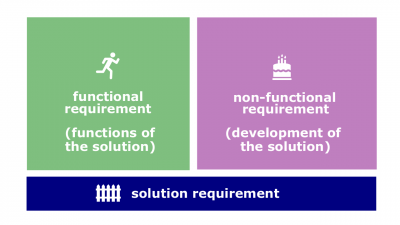Difference between revisions of "Solution requirement"
(→Related coursework) |
(→Related concepts) |
||
| Line 6: | Line 6: | ||
*[[Technical requirement]]. A set of technical properties that a product must fulfill. | *[[Technical requirement]]. A set of technical properties that a product must fulfill. | ||
*[[Transition requirement]](s). A classification of requirements that describe capabilities that the solution must have in order to facilitate transition from the current state of the enterprise to the desired future state, but that will not be needed once that transition is complete. | *[[Transition requirement]](s). A classification of requirements that describe capabilities that the solution must have in order to facilitate transition from the current state of the enterprise to the desired future state, but that will not be needed once that transition is complete. | ||
| + | |||
| + | ==Draft descriptions== | ||
| + | Solution Requirements describe what characteristics a solution will have to meet the needs of the stakeholders and business. Similar to how multiple scenarios of stakeholder requirements could satisfy a business requirement, hence the need to translate and trace stakeholder requirements to business requirements, also multiple scenarios of solution requirements could satisfy a stakeholder requirement, hence the need to translate and trace stakeholder requirements to solution requirements. A few key points: | ||
| + | |||
| + | Solution Requirements describe WHAT characteristics the solution will support. | ||
| + | From a stakeholder perspective the Solution Requirements may be viewed as describing HOW the Solution Requirements will meet the stakeholder need, but even from this perspective it would define the HOW logically and at a high level rather than give details of the implementation of the solution | ||
| + | |||
| + | Solution Requirements can be further categorized into: | ||
| + | |||
| + | Functional Requirements which describe the behavior of the solution and the information managed. In the case of a system, these are the features and functions of the system. | ||
| + | Non-Functional Requirements define the qualities of the solution or the environmental conditions under which the solution will remain effective. In terms of a technical system solution this often refers to characteristics of capacity, speed, security, availability, etc. | ||
==Related concepts== | ==Related concepts== | ||
| − | *[[Business requirement]]. A higher level business rationale that, when addressed, will permit the organization to increase revenue, avoid costs, improve service, or meet regulatory requirements. | + | *[[Business requirement]]. A higher level business rationale that, when addressed, will permit the organization to increase revenue, avoid costs, improve service, or meet regulatory requirements. |
==Related lectures== | ==Related lectures== | ||
Revision as of 22:31, 31 March 2020
Solution requirement (hereinafter, the Requirement) is a characteristic of a solution that meets the business and stakeholder requirements. May be subdivided into functional and non-functional requirements.
Types
- Functional requirement. Any requirement that refers to the product capabilities. In other words, a functional requirement describes what the product must do for its users. In systems engineering, a functional requirement is a particular behavior or metric to judge the operation of a system.
- Non-functional requirement(s). The quality attributes, design and implementation constraints, and external interfaces that the product must have.
- Technical requirement. A set of technical properties that a product must fulfill.
- Transition requirement(s). A classification of requirements that describe capabilities that the solution must have in order to facilitate transition from the current state of the enterprise to the desired future state, but that will not be needed once that transition is complete.
Draft descriptions
Solution Requirements describe what characteristics a solution will have to meet the needs of the stakeholders and business. Similar to how multiple scenarios of stakeholder requirements could satisfy a business requirement, hence the need to translate and trace stakeholder requirements to business requirements, also multiple scenarios of solution requirements could satisfy a stakeholder requirement, hence the need to translate and trace stakeholder requirements to solution requirements. A few key points:
Solution Requirements describe WHAT characteristics the solution will support. From a stakeholder perspective the Solution Requirements may be viewed as describing HOW the Solution Requirements will meet the stakeholder need, but even from this perspective it would define the HOW logically and at a high level rather than give details of the implementation of the solution
Solution Requirements can be further categorized into:
Functional Requirements which describe the behavior of the solution and the information managed. In the case of a system, these are the features and functions of the system. Non-Functional Requirements define the qualities of the solution or the environmental conditions under which the solution will remain effective. In terms of a technical system solution this often refers to characteristics of capacity, speed, security, availability, etc.
Related concepts
- Business requirement. A higher level business rationale that, when addressed, will permit the organization to increase revenue, avoid costs, improve service, or meet regulatory requirements.
